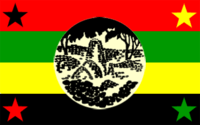BTR-152
| BTR-152 | |
|---|---|
|
| |
| Type | Armored personnel carrier |
| Place of origin | Soviet Union |
| Service history | |
| In service | 24 March 1950 - 1990s |
| Used by | See Operators |
| Wars | See Service History |
| Production history | |
| Designer | B. M. Fitterman |
| Designed | November 1946 - 1949[1] |
| Manufacturer |
Automotive Factory No. 2 Zavod imeni Stalina (until 1956)[1] Automotive Factory No. 2 Zavod imeni Likhacheva (from 1956 to 1962)[1] |
| Produced | 1950 - 1959 |
| Number built | around 15,000 |
| Variants | See Variants |
| Specifications | |
| Weight | 9.91 tonnes[2] |
| Length |
6.55 m 6.83 m for BTR-152V |
| Width | 2.32 m |
| Height |
2.04 m (without the mg)[2] 2.36 m (with the mg)[1] 2.41 m (BTR-152V with the mg)[1] |
| Crew | 2 (+18 passengers)[3] |
|
| |
| Armor |
welded steel[4] 15 mm front[2] 9 mm sides and rear[4] 10 mm roof[4] 4 mm bottom[4] |
Main armament | 7.62mm SGMB light machine gun (1,250 rounds) (12.7 mm DShK 1938/46 heavy machine gun (500 rounds) can be used instead)[2] |
Secondary armament | 2x7.62mm SGMB light machine guns (1,250-1,750 rounds) on side pintel mounts (optional)[2] |
| Engine |
ZIS-123 6-cylinder in-line water-cooled petrol (for variants based on ZiS-151) ZiL-137K 6-cylinder in-line petrol (for variants based on ZiL-157)[5] 110 hp (82 kW) at 3,000 rpm. (for variants based on ZiS-151) 107 hp (80 kW) (for variants based on ZiL-157)[5] |
| Power/weight |
11.1 hp/tonne (8.3 kW/tonne) 10.8 hp/tonne (8.1 kW/tonne) for BTR-152V[1] |
| Suspension |
wheeled 6×6 front - 2 leaf springs and hydraulic shock absorbers. rear - equalising type with 2 leaf springs and torsion bars. |
| Ground clearance | 300 mm |
| Fuel capacity | 300 l (79 gal) |
Operational range | 650 km (404 miles)[2] |
| Speed |
75 km/h[6] 65 km/h for BTR-152V[1] |
The BTR-152 (also known as BTR-140) was a six-wheeled Soviet armored personnel carrier (БТР, from Бронетранспортер/Bronetransporter, literally "armored transporter") †, built on the chassis and drive train of a ZiS-151 utility truck. It entered service with a number of Warsaw Pact member states beginning in 1950, and formed the mainstay of Soviet motor rifle battalions until the advent of the amphibious BTR-60 series during the 1960s.[7]
BTR-152s were available in several marks and manufactured in large numbers for the Soviet military and export. Late production models utilized automotive components from the more reliable ZIL-157 truck.[8] Three primary variants of the BTR-152 appeared between 1950 and 1959: the base armored personnel carrier with a single pintle-mounted 7.62mm or 12.7mm machine gun, an unarmed command vehicle with a higher roofline, and an anti-aircraft variant armed with a ZPU-2 mount.[8] BTR-152s could carry a single infantry squad each, or specialist weapons teams along with their mortars and anti-tank equipment. In Soviet service, a number were also deployed as artillery tractors.[9]
History
Development
During World War II, Red Army tacticians favored combined arms offensives, which emphasized the deployment of light infantry in concert with tanks. However, the Soviet infantrymen lacked the armored protection and rapid mobility of the tanks, and remained comparatively vulnerable to enemy fire.(Perrett 1987:65)
By the end of the war, the initial Soviet tactic of tank desant, in which the infantry rode into battle atop the tanks they were supporting, had been superseded by the introduction of M3 Half-tracks and M3 White armored cars.[10] These were widely used for troop transport, giving rise to a new doctrine in which armored vehicles capable of keeping pace with tanks brought infantry to an engagement. The infantrymen would then debark and enter combat dismounted.[11]
Wartime experiences demonstrated that the Red Army had an urgent postwar requirement for more wheeled armored vehicles, and the general staff specified a new reconnaissance vehicle and armored personnel carrier (APC).[10] The APC had to be capable of transporting at least eight troops. A new design bureau at the Gorkovsky Avtomobilny Zavod (GAZ) was set up to study potential concepts accordingly; their final prototype, the Izdeliye 141 (BTR-40), was accepted into service but was regarded as too small to be used in an APC role.[10] Meanwhile, specifications for another APC had been issued, capable of seating 15 to 20 additional passengers and armed with a single heavy machine gun.[12] Existing M3 half-tracks and captured German SdKfz 251s were studied as potential references for the upcoming pre-production design. (Perrett 1987:65)
Concept work on the new APC began at the Zavod imeni Stalina (ZiS) factory in Moscow, overseen by Soviet engineer Boris Mikhailovich Fitterman, at roughly the same time the Izdeliye 141 was being developed by GAZ. Prototypes were built with automotive components from the ZiS-151 production line; however, the APC chassis incorporated a more powerful engine and a shorter wheelbase than its utility truck counterpart.[12] Design work was carried out by a team of five ZiS employees: Fitterman, K. M. Androsov, A. P. Petrenko, V. F. Rodionov and P. P. Chernyaev.[1] The final prototype was trialed by the Soviet Armed Forces in December 1949 and accepted into service as the BTR-152.[12] Serial production of the BTR-152 under the manufacturer's code ZiS-152 commenced around mid 1950, making it the first mass produced Soviet APC.[9] Despite being designed around the same time, the BTR-40 did not enter serial production until the end of the year.[10]
The BTR-152 was used by the Soviet military as a command and communications vehicle, fire support vehicle, artillery tractor, and general transporter.[9] Being open-topped, the BTR-152's crew was vulnerable to indirect fire. In later years, the vehicle was not ideal for the prospect of a major conventional war in Europe either, as it lacked amphibious capability or NBC countermeasures.[9] However, these early BTRs remained effective as a low-cost option that allowed the Soviets to rapidly motorize their existing infantry divisions.[11] A program in the late 1950s looked at ways to replace the BTR-152 with a more sophisticated APC utilizing a purpose-designed, amphibious chassis.[9] As the BTR-152's six-wheeled configuration was deemed insufficient to reduce ground pressure on the tires and produce optimal cross-country performance, Soviet engineers embarked on an eight-wheeled APC program, which resulted in the BTR-60.[11]
Approximately 8,600 BTR-152s of all variants were manufactured in the Soviet Union,[12] with some unlicensed copies being produced in the People's Republic of China as the Type 56.[13] Soviet BTR-152s were produced between 1950 and 1959, being supplemented by the BTR-60 from 1960 onwards.[9] As they became increasingly obsolescent, many were shipped to Soviet client states in Africa and the Middle East; the largest quantity of second-hand BTR-152s were accepted by Arab nations such as Libya, Iraq, Syria, and Egypt.[11]
Service

BTR-152s first saw combat during the Hungarian Revolution of 1956, when they were deployed by the 12th Motorized Brigade of the Soviet Internal Troops to crush the Hungary's fledgling uprising.[14] The BTRs were deployed in Budapest and other settlements, as well as on the Hungarian border with Austria.[14] A number were damaged or destroyed by insurgents armed with molotov cocktails, which were pitched into the open troop compartments without apparent difficulty.[12] Since they were wheeled, some BTR-152s were also immobilized when their rubber tires caught fire, and had to be abandoned by their crews.[14]
Egypt was one of the first major export customers for the BTR-152 outside Eastern Europe; in 1954, it ordered 200 from the Soviet Union, and between 1961 and 1966 it received another 600 in second-hand condition, possibly as military aid.[13] Syria likewise received at least 200 BTR-152s in 1966, and another 300 three years later. These were deployed against the Israel Defense Forces during the Six Day War.[11] In Syrian service, they were utilized as makeshift infantry fighting vehicles rather than APCs; infantrymen remained mounted and used the BTR-152 as a firing platform rather than debark and fight on foot.[15] Nevertheless, failure to coordinate combined arms maneuvers often left the Syrian motorized infantry separated from their supporting tank formations and vulnerable to Israeli heavy armor.[15] Israel captured over 1,000 BTR-152s from Arab armies during the Six Day War and the subsequent Yom Kippur War.[16]
BTR-152s were deployed by the National Liberation Front of Chad (FROLINAT) during the First Chadian Civil War, and were instrumental in a motorized assault on Salal in April 1978. The BTRs were knocked out by Panhard AML-90 armored cars of the French Foreign Legion.[17] Libyan mechanized battalions also deployed BTR-152s in Chad during the Chadian-Libyan conflict, often in concert with tank companies or EE-9 Cascavels. Several were destroyed after taking direct hits from AML-90 cannon fire or SS.11 anti-tank missiles.[17]
BTR-152s formed the mainstay of mechanized units on both sides during the Ogaden War. The Somali National Defense Force (SNDF) ordered enough BTR-152s from the Soviet Union in the late 1960s to accommodate a massive expansion in its armored and mechanized capabilities, and equip nine new mechanized battalions.[18] About half of Somalia's BTR-152s appear to have been lost in the Ogaden conflict.[19] Soviet weapons deliveries to Ethiopia accelerated after the outbreak of war, and starting in March 1977 included 40 BTR-152s appropriated from the Soviet Army's reserve stocks.[20] These vehicles were mostly BTR-152Vs[21] but also included the BTR-152A anti-aircraft variant.[22]
The Soviet Union donated at least six BTR-152s to Mozambique shortly after that country's independence in the mid 1970s.[13] Mozambican BTR-152s were deployed against Rhodesian Security Forces conducting cross-border raids,[23] as well as in search and destroy operations mounted near Mozambican National Resistance (RENAMO) strongholds.[24] It is likely that all Mozambique's BTR-152s were eliminated by land mines or Rhodesian air strikes;[24] they were not in service long before being superseded by the BTR-60.[25] A second shipment of BTR-152s was delivered to the People's Forces of Liberation of Mozambique (FPLM) in 1983, but it remains unclear whether these were deployed in front-line service.[13]
Description
The BTR-152 is a modified truck chassis with an armored hull and an open-topped troop compartment. The sides and rear of the troop compartment are vertical, with corners sloping inwards to deflect shell fragments.[26] There are firing ports on each side of the troop compartment and two rear doors for rapid debarking.[26] Infantrymen can fire their individual weapons from the relative protection of the vehicle, and exit through these doors or by jumping over the sides. The crew consists of a driver and a single passenger, who operates the radios.[26]
Two types of seating arrangements were available: the first consists of wooden benches on either side of the troop compartment facing inwards; the second consisted of three rows of seats facing forward.[9] Both the driver and the radio operator seated to his right are provided with individual windscreens and, when in combat, these are covered by twin armored shutters with integral vision blocks.[9] Crew members exit the vehicle through side doors, the tops of which are hinged and fold down for observation purposes.[9]
The BTR-152's armor plate is fabricated of welded steel and ranges from 4 mm (0.16 in) to 13.5 mm (0.53 in) in thickness.[9] This protects the crew and passengers from small arms fire, shell fragments, grenades, and anti-personnel mines, but is ineffective against larger shell fragments or even heavy machine gun fire. Late production hulls may have been manufactured from steel plate with a thickness of up to 15 mm (0.59 in).[2] The vehicle is sometimes fitted with a winch that has a maximum capacity of 5 tonnes and a 70m cable.[2][4] Depending on the variant, BTR-152s can tow field artillery, transport 1.9 tonnes of cargo, or carry a half platoon of infantry.[1][4][27]
Most Soviet BTR-152s were powered by a six cylinder ZiL-123 in-line water-cooled petrol engine developing 110hp at 2,900 rpm.[9] Those based on the chassis and components of the ZiL-157 utility truck utilized a slightly different ZiL-137K engine.[5] There are several engine louvers on the front of the hull to prevent overheating; these could be safely closed for short intervals during combat, as long as the driver reduced speed and avoided overtaxing the vehicle.[4] A BTR-152's gearbox comprised five forward gears and one reverse gear with a two-speed transfer box. Fifth gear had an overdrive.[9] The uspension consisted of conventional leaf springs with hydraulic shock absorbers.[9]
In the late 1950s, a little over 200 BTR-152s were produced with enclosed hulls, as opposed to the traditionally open-topped design; these were designated BTR-152K and BTR-152K1. They were also known unofficially as "BTR-152 Model D" or "BTR-152 M1961" by some Warsaw Pact armies.[9] The enclosed hull reduced situational awareness but allowed for the installation of central heating and an NBC overpressure system.[12] Two hatches opening to the right were installed on the new roofline.[9]
The BTR-152 was originally armed with a single pintle-mounted 7.62mm SG-43 Goryunov (SGMB) medium machine gun, fed by 1,250 rounds of stored on-board ammunition. This was mounted behind the driving position.[9] Additional 7.62mm general-purpose machine guns could be mounted on either side of the hull top as needed.[9] The SGMB machine gun could traverse 45 degrees and elevate between -6 and +24 degrees.[4] Some of the BTRs were fitted with single 12.7mm DShK or 14.5mm KPV heavy machine guns in place of the SGMB.[9] Vehicles designated BTR-152A were ground support vehicles with limited air defense capability. BTR-152As carried twin KPVs in a ZPU-2 anti-aircraft mount.[9] Variations included an Egyptian model with a Czechoslovak M53 Quad mounting for four DShKs, which were normally towed on a two-wheeled trailer, and some modified by the Palestine Liberation Organization to accept 23mm ZU-23-2 anti-aircraft guns.[28]
Because the original BTR-152 utilized the chassis and engine of the ZiS-151, it shared that truck's maintenance problems and poor cross-country mobility. Later variants, using ZiL-157 components, had more power and larger, single tires that reduced the vehicle's shortcomings but did not entirely eliminate them. Serviceability and reliability remained low.[27]
Variants
Former Soviet Union
- BTR-152 (1950) - Basic APC based on ZiS-151 truck, many of which would later be covered and converted for other uses, such as ambulances, radio stations, and engineer vehicles. The basic BTR-152 has no winch, an open top, and no tire pressure control lines.[2]
- BTR-152A (1951) - BTR-152 converted into a SPAAG armed with a double (ZPTU-2) or quadruple (ZPTU-4) KPVT 14.5 mm antiaircraft heavy machine guns (2400 rounds) in a turret manually operated by a single soldier. The entire vehicle crew consisted of eight soldiers in the variant equipped with ZPTU-2 and five soldiers in the variant equipped with ZPTU-4. The turret is placed inside the troop compartment and can be manually operated by a single soldier. It can make a full turn and its guns can elevate between -5 and +80 degrees.[2][4][29]
- BTR-152 converted into a minelayer equipped with racks for anti-tank mines.[27]
- BTR-152B (1952) - Artillery command version with a front-mounted winch and external tires pressure regulation system.[2][27]
- BTR-152C - Communication variant based on BTR-152.[29]
- BTR-152V (1955) - Variant based on ZIL-157 truck with external tires pressure regulation system, a front-mounted winch and night vision devices for the driver.[4]
- BTR-152D (1955) - Armament as BTR-152A, but based on BTR-152V.
- BTR-152I - BTR-152V version for artillery command vehicle.[2]
- BTR-152S - Command and communication post vehicle for infantry commanders. It has a significantly higher full cover roof and additional radios and antennas.[1][27]
- BTR-152V1 (1957) - Received night vision equipment, winch, open top and improved external tires pressure regulation system.[2]
- BTR-152K (1959) - Received an armored roof with three big hatches on top of it, two of which opened to the right over the troop compartment, an internal tires pressure regulation system and a filtering/ventilating system. The weight of the vehicle has increased, the crew went down from 2+18 to 2+13.[4][27][29]
- BTR-152K converted into an armored ambulance.
- BTR-152E - Armament as BTR-152A, but based on BTR-152V1.
- BTR-152U - Command vehicle based on BTR-152V1 equipped with external tires pressure regulation system. This command vehicle has a significantly higher full cover roof and additional radios and antennas. It has equipment for staff operations. This vehicle normally tows a trailer carrying additional equipment.[2][4][27]
- BTR-152K (1959) - Received an armored roof with three big hatches on top of it, two of which opened to the right over the troop compartment, an internal tires pressure regulation system and a filtering/ventilating system. The weight of the vehicle has increased, the crew went down from 2+18 to 2+13.[4][27][29]
- BTR-152V2 - BTR-152V version without winch. It has the internal tire pressure regulation system.[2]
- BTR-152V3 - BTR-152V with winch on the front, open top, infrared driving lights, and internal tire pressure regulation system.[2]
- BTR-E152V (1957) - Experimental version; the second pair of wheels was moved toward the center of the vehicle in order to improve off-road performance.
People's Republic of China
- Type 56 - Chinese copy.

Egypt
- BTR-152 converted by Egyptians into a SPAAG armed with Czechoslovak KLAD (Egyptian designation is M58) quadruple DShK 1938/46 12.7 mm anti-aircraft heavy machineguns mounted in the troop compartment. It was withdrawn from service in middle of the 1980s.[2][6][27]
former East Germany

- SPW-152 - East German version of BTR-152.[27]
Israel
- BTR-152 captured from Syrians or Egyptians and modified to fulfil the Israeli Army needs.[27]
- BTR-152 TCM-20 - Israeli air defense vehicle based on ex-Syrian or ex-Egyptian BTR-152. It is armed with twin 20 mm cannon in a TCM-20 powered mount.[27]
Lebanon
- BTR-152 modified by Lebanese militias. It was fitted with a ZU-23-2 anti-aircraft gun placed inside the troop compartment. It was used in fire support and anti-aircraft roles.[27]
- BTR-152 modified by the South Lebanese Army. It was fitted with a crane inside a cut down troop compartment. One surviving example is at Yad la-Shiryon Museum in Latrun.[27]
Poland
- BTR-152 converted to serve as a mobile command post. It has additional radios.[27]
- BTR-152 converted into an engineering vehicle.[1]
- BTR-152 converted into an armored artillery tractor.[1]
Vietnam
- Unknown name upgraded version carried out by the Vietnam's Institute of Military Vehicle Technology in 2011. The upgraded version uses a diesel engine with a new gearbox, new driving system with hydraulic transmission, additional armored hood, improved suspension and electricity, lights, optics and other modifications. The upgraded BTR-152 is claimed to have higher speed, lower fuel consumption and is easier to use.[31][32][33]
Operators

Current operators
 Angola: 50[13]
Angola: 50[13] Cambodia: 30[13]
Cambodia: 30[13] China: Reverse engineered as the Type 56[13]
China: Reverse engineered as the Type 56[13] Congo: 20[13]
Congo: 20[13] Cuba: 150[13]
Cuba: 150[13] Equatorial Guinea: 10[13]
Equatorial Guinea: 10[13] Ethiopia: 100[13]
Ethiopia: 100[13] Guinea: 6[13]
Guinea: 6[13] Guinea-Bissau: 20; Type 56 variant[34]
Guinea-Bissau: 20; Type 56 variant[34] Laos[26]
Laos[26] Mali: 10[13]
Mali: 10[13] Mongolia: 50[13]
Mongolia: 50[13] Mozambique: 106[13]
Mozambique: 106[13] Namibia: 6[35]
Namibia: 6[35] Nicaragua: 120[13]
Nicaragua: 120[13] North Korea: 350[13]
North Korea: 350[13] Seychelles[36]
Seychelles[36] Sudan: 37[13]
Sudan: 37[13] Syria: 600[13]
Syria: 600[13] Tanzania: 55, 30 BTR-152 and 25 Type 56[13]
Tanzania: 55, 30 BTR-152 and 25 Type 56[13] Uganda: 74[13]
Uganda: 74[13] Vietnam: 160, 100 BTR-152 and 60 Type 56[13]
Vietnam: 160, 100 BTR-152 and 60 Type 56[13] Zimbabwe: 16[37]
Zimbabwe: 16[37]
Former operators
 Afghanistan: 100[13]
Afghanistan: 100[13] Albania[8]
Albania[8] Algeria: 350[13]
Algeria: 350[13] Bulgaria[8]
Bulgaria[8] Central African Republic[26]
Central African Republic[26] Cyprus: 32[38]
Cyprus: 32[38] East Germany: 759; German designation SPW-152[13]
East Germany: 759; German designation SPW-152[13] Egypt: 1,000; likely replaced by the Walid[13]
Egypt: 1,000; likely replaced by the Walid[13] Estonia: 5[39]
Estonia: 5[39] FROLINAT[17]
FROLINAT[17] Hungary: 160[13]
Hungary: 160[13] India: 250[13]
India: 250[13] Indonesia: 30[13]
Indonesia: 30[13] Iran: 300[13]
Iran: 300[13] Iraq: 200[13]
Iraq: 200[13] Israel: 1,500; captured from Egypt and Syria[16]
Israel: 1,500; captured from Egypt and Syria[16].svg.png) Libya[11]
Libya[11] North Yemen: 20[13]
North Yemen: 20[13] Palestinian Liberation Organization[8]
Palestinian Liberation Organization[8] Progressive Socialist Party[40]
Progressive Socialist Party[40] Poland: 400[13]
Poland: 400[13] Romania: 100[13]
Romania: 100[13] Somalia: 265[13]
Somalia: 265[13] South Yemen: 100[13]
South Yemen: 100[13] Soviet Union[7]
Soviet Union[7] Sri Lanka: 10[13]
Sri Lanka: 10[13] Yugoslavia: 40[13]
Yugoslavia: 40[13] Zimbabwe People's Revolutionary Army (ZIPRA): 15[41]
Zimbabwe People's Revolutionary Army (ZIPRA): 15[41]
See also
Notes
- 1 2 3 4 5 6 7 8 9 10 11 12 softland
- 1 2 3 4 5 6 7 8 9 10 11 12 13 14 15 16 17 "BTR-152 Armored Transporter". Retrieved 24 December 2014.
- ↑ BTR-152
- 1 2 3 4 5 6 7 8 9 10 11 12 Administrator. "BTR 152 [ZSRR] - Pancerni.net". Retrieved 24 December 2014.
- 1 2 3 AMW - Agencja Mienia Wojskowego
- 1 2 Administrator. "BTR 152 [ZSRR]: Strona 2 - Pancerni.net". Retrieved 24 December 2014.
- 1 2 Green, Michael (1997). Armoured Warfare in the Vietnam War: Rare Photographs from Wartime Archives. South Yorkshire: Pen & Sword Books Ltd. pp. 68–69. ISBN 978-1781593813.
- 1 2 3 4 5 Pretty, Ronald. Jane's Weapon Systems, 1979–80 (1979 ed.). Macdonald and Jane's Publishers Ltd. pp. 313–368. ISBN 978-0-531-03299-2.
- 1 2 3 4 5 6 7 8 9 10 11 12 13 14 15 16 17 18 19 Christopher F. Foss. Jane's World Armoured Fighting Vehicles (1976 ed.). Macdonald and Jane's Publishers Ltd. pp. 262–269. ISBN 0-354-01022-0.
- 1 2 3 4 Kinnear, James (2008). Russian Armored Cars 1930-2000. Darlington, MD (USA): Darlington Productions Inc. pp. 189–190. ISBN 1-892848-05-8.
- 1 2 3 4 5 6 Tucker, Spencer. The Encyclopedia of Middle East Wars: The United States in the Persian Gulf, Afghanistan, and Iraq Conflicts, Volume 1. Santa Barbara, California, USA: ABC-CLIO, 2010. Pp. 243
- 1 2 3 4 5 6 "Krasnaya Zvezda: BTR-152". Cherbourg-en-Cotentin, France: Elephorm en Alsacréations, Lopez, and Houbre. 2010. Archived from the original on 28 October 2014. Retrieved 29 October 2016.
- 1 2 3 4 5 6 7 8 9 10 11 12 13 14 15 16 17 18 19 20 21 22 23 24 25 26 27 28 29 30 31 32 33 34 35 36 37 38 "Trade Registers". Armstrade.sipri.org. Retrieved 2013-06-20.
- 1 2 3 Schmidl, Erwin A.; Ritter, László (2006). The Hungarian Revolution 1956. Oxford: Osprey Publishing. pp. 32–47. ISBN 9781846030796.
- 1 2 Campbell, David (2016). Israeli Soldier vs Syrian Soldier: Golan Heights 1967–73. Oxford: Osprey Publishing. pp. 1–61. ISBN 978-1472813305.
- 1 2 Cordesman, Anthony H. (2006). Arab-Israeli Military Forces in an Era of Asymmetric War. Greenwood Publishing Group. p. 132. ISBN 0275991865.
- 1 2 3 Tom Cooper & Albert Grandolini. Libyan Air Wars: Part 1: 1973–1985 (2015 ed.). Helion & Co. Ltd. pp. 39—37. ISBN 978-1-909982-39-0.
- ↑ Cooper, Thomas (2015). Wings over Ogaden: The Ethiopian-Somali War, 1978-1979. Solihull: Helion & Company. pp. 21–22. ISBN 978-1909982383.
- ↑ Cordesman, Anthony (2016). After The Storm: The Changing Military Balance in the Middle East in the 20th century. London: Bloomsbury Academic. p. 733. ISBN 978-1474292573.
- ↑ Porter, Bruce D. (1986). The USSR in Third World Conflicts: Soviet Arms and Diplomacy in Local Wars. Cambridge: Cambridge University Press. pp. 200–201. ISBN 978-0521310642.
- ↑ Ayele, Fantahun (2014). The Ethiopian Army: From Victory to Collapse, 1977-1991. Evanston, Illinois (US): Northwestern University Press. pp. 113–114. ISBN 978-0810130111.
- ↑ Isby, David (1981). Weapons and Tactics of the Soviet Army. London: Jane's Information Group. pp. 113–114. ISBN 978-0710603524.
- ↑ Moorcraft, Paul L.; McLaughlin, Peter (April 2008) [1982]. The Rhodesian War: A Military History. Barnsley: Pen and Sword Books. pp. 96–97. ISBN 978-1-84415-694-8.
- 1 2 Wessels, Hannes (2015). A Handful of Hard Men: The SAS and the Battle for Rhodesia (First ed.). Philadelphia: Casemate Publishers. pp. 240–241. ISBN 978-1612003450.
- ↑ Emerson, Stephen A. (2014). The battle for Mozambique: the Frelimo-Renamo struggle, 1977-1992. Helion and Company. p. 89. ISBN 1909384925.
- 1 2 3 4 5 Christopher F. Foss. Jane's Tanks and Combat Vehicles Recognition Guide (2000 ed.). Harper Collins Publishers. p. 376. ISBN 978-0-00-472452-2.
- 1 2 3 4 5 6 7 8 9 10 11 12 13 14 15 16 17 18 19 JED The Military Equipment Directory
- ↑ Chant, Christopher (1987). A Compendium of Armaments and Military Hardware. New York: Routledge & Kegan Paul. pp. 61–68. ISBN 0-7102-0720-4. OCLC 14965544.
- 1 2 3 "-152 (BTR-152 armored personnel carrier) :: -. (r1a.ru)". Retrieved 24 December 2014.
- ↑ BTR-152 armored personnel carrier
- ↑ Điểm qua một số chương trình nâng cấp vũ khí nổi bật của VN (P3) - 10. Nâng cấp xe thiết giáp BTR-152 Soha.vn (Vietnamese)
- ↑ Việt Nam nâng cấp thành công “ông già thép” BTR-152 Kienthuc.net.vn (Vietnamese)
- ↑ Nghiệm thu cải tiến, nâng cấp xe thiết giáp BTR-152 Quân Đội Nhân Dân (Vietnamese)
- ↑ "Guinea-Bissau Fact Files". Institute for Security Studies Africa. 2009. Retrieved 2014-12-01.
- ↑ Guy Martin. "Namibia Defence Force". Retrieved 24 December 2014.
- ↑ "Seychelles People's Defence Forces". defenceweb.co.za. 29 October 2013. Retrieved 4 November 2016.
- ↑ Simon Baynham. Zimbabwe in transition (October 1992 ed.). Almqvist & Wiksell International. p. 240. ISBN 978-9122015086.
- ↑ Henn, Francis (2004). A Business of Some Heat: The United Nations Force in Cyprus Before and During the 1974 Turkish Invasion. Casemate Publisher. pp. 67–68. ISBN 9781844150816. Retrieved 16 March 2015.
- ↑ Armia magazine issue 8/09
- ↑ Kassis, 30 Years of Military Vehicles in Lebanon (2003), p. 58.
- ↑ Touchard, Guerre dans le bush! Les blindés de l’Armée rhodésienne au combat (1964-1979), p. 70.
Further reading
- Bryan Perrett, Soviet Armour Since 1945, Blandford Press, London 1987. ISBN 0-7137-1735-1
- David Markov & Steven J. Zaloga, Soviet/Russian Armor and Artillery Design Practices - 1945 to Present, Andrew Hull. ISBN 1-892848-01-5
- Jane's Armour and Artillery 2005–2006
- Moustafa El-Assad, Civil Wars Volume 1: The Gun Trucks, Blue Steel books, Sidon 2008. ISBN 978-9953012568
- Samer Kassis, 30 Years of Military Vehicles in Lebanon, Beirut: Elite Group, 2003. ISBN 9953-0-0705-5
- Samer Kassis, Véhicules Militaires au Liban/Military Vehicles in Lebanon 1975-1981, Trebia Publishing, Chyah 2012. ISBN 978-9953-0-2372-4
- Samuel M. Katz and Ron Volstad, Battleground Lebanon, Concord Publications, Hong Kong 1990. ISBN 962-361-003-3
- Laurent Touchard, Guerre dans le bush! Les blindés de l’Armée rhodésienne au combat (1964-1979), Batailles & Blindés Magazine n.º 72, April–May 2016, pp. 64–75. ISSN 1765-0828 (in French)
External links
| Wikimedia Commons has media related to BTR-152. |
- BTR-152 foto and forum
- FAS.org
- FAS.org
- Photo gallery at armyrecognition.com
- Description and photo gallery at Slujba.ru (Russian language)
- Description and photo gallery at armoured.vif2.ru (Russian language)
- BTR-152 at U.S. Veterans Memorial Museum